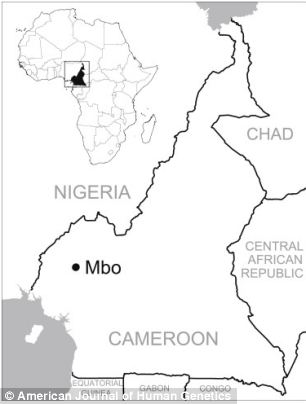DNA Evidence Suggests Man 340,000-Years-Old...

The family tree that rewrote human history: Researchers stunned to find DNA submitted to online project dates back 338,000 years
7 March 2013 | Discovery made after American submitted his DNA to a family tree service; DNA traced to Mbo, a population living in a tiny area of western Cameroon; Proves last common Y chromosome ancestor lived 338,000 years ago, even though oldest fossil of modern man is only 200,000 years old

The family tree that rewrote human history: Researchers stunned to find DNA submitted to online project dates back 338,000 years
7 March 2013 | Discovery made after American submitted his DNA to a family tree service; DNA traced to Mbo, a population living in a tiny area of western Cameroon; Proves last common Y chromosome ancestor lived 338,000 years ago, even though oldest fossil of modern man is only 200,000 years old
A DNA test on an American hoping to trace his family tree has come up with a stunning result - the roots of the human tree date back much further than previously thought. Researchers were shocked when they analysed the DNA of Albert Perry, a recently deceased African-American from South Carolina. 'This lineage diverged from previously known Y chromosomes about 338,000 years ago, a time when anatomically modern humans had not yet evolved,' said Michael Hammer of the University of Arizona. "This pushes back the time the last common Y chromosome ancestor lived by almost 70 percent.'
This time predates the age of the oldest known anatomically modern human fossils. The fossil record dates back about 200,000 years, said Hammer. Either interbreeding with Neanderthals or other populations led to the unusual genetic makeup, he said, or humans evolved far earlier than the extant fossil record suggests. The new divergent lineage - which was found when Mr Perry contacted Family Tree DNA, a company specializing in DNA analysis to trace family roots - branched from the Y chromosome tree before the first appearance of anatomically modern humans in the fossil record.

The team found a similar chromosome in the Mbo, a population living in a tiny area of western Cameroon in sub-Saharan Africa
Unlike the other human chromosomes, the majority of the Y chromosome does not exchange genetic material with other chromosomes, which makes it simpler to trace ancestral relationships among contemporary lineages. If two Y chromosomes carry the same mutation, it is because they share a common paternal ancestor at some point in the past. The more mutations that differ between two Y chromosomes the farther back in time the common ancestor lived. The results are published in the American Journal of Human Genetics.
Originally, Mr Perry's DNA sample was submitted to the National Geographic Genographic Project. When none of the genetic markers used to assign lineages to known Y chromosome groupings was found, the DNA sample was sent to Family Tree DNA for sequencing. Fernando Mendez, a postdoctoral researcher in Hammer's lab, led the effort to analyze the DNA sequence, which included more than 240,000 base pairs of the Y chromosome. Hammer said: 'The most striking feature of this research is that a consumer genetic testing company identified a lineage that didn't fit anywhere on the existing Y chromosome tree, even though the tree had been constructed based on perhaps a half-million individuals or more. 'Nobody expected to find anything like this.'
Read more: The family tree test that rewrote human history: Researchers stunned to find DNA submitted to online service dates back 338,000 years | Mail Online









